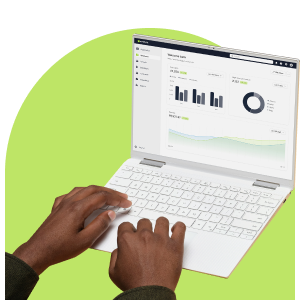Effective client engagement builds trust and drives loyalty, which are crucial for the sustained growth of financial institutions. With clients expecting personalised and timely interactions, more advanced communication methods are required. This is where automated bulk marketing workflows come into play, offering a sophisticated approach to managing client interactions.
Two Major Benefits of Automated Workflows for the Finance Industry
Financial institutions often face two significant challenges: your sheer volume of clients and interactions that need to be managed and the need for personalisation. Clients expect communications that are tailored to their circumstances. However, manually creating personalised content for each client is not feasible, especially as your client base grows. This is where automated marketing workflows can make a significant difference.
Automated marketing workflows address these challenges by streamlining your communication process. They enable you to set up predefined actions triggered by specific client behaviours or finance events. For example, when a new client signs up, an automated onboarding workflow can send a series of personalised welcome emails, guide the client through their initial setup, and provide them with relevant information and resources.
Similarly, lead nurturing workflows can keep potential clients engaged by sending targeted content based on their interests and interactions. This keeps the institution top-of-mind and gradually moves your leads closer to conversion.
Automation ensures consistency in your communication. Once workflows are set up, they run automatically, ensuring no client is overlooked and your core message stays the same. This consistency helps build trust, as clients receive regular, reliable updates.
Efficiency is another important benefit. Automated workflows save time and reduce the burden on your staff, empowering them to focus on more strategic tasks. This efficiency is particularly valuable in the finance industry, where accuracy and timeliness are important.
Take your emails to the next level with nine powerful personalisation techniques that help you stand out!
Leveraging Automated Marketing Workflows Effectively
Automated marketing workflows are a game-changer for financial institutions looking to enhance client engagement. These workflows allow for the systematic delivery of personalised content and communications, ensuring that each client receives the attention and information they need when they need it. Here are some ideas for leveraging marketing workflows in your email communication.
A Personalised Onboarding Process
The onboarding process is an important phase in establishing strong client relationships. Automated workflows can streamline this process by delivering tailored communications that welcome your new clients, guide them through initial steps, and provide necessary resources.
Nurturing Leads to Convert Prospects
In the competitive finance industry, nurturing leads is essential for converting prospects into clients. Automated workflows can keep potential clients engaged with relevant and timely content.
Keep Communication Consistent, Efficient, and Accurate
Automated workflows ensure messages are sent at the best times and frequency without overwhelming your clients. Regular updates, newsletters, and personalised messages can be scheduled and triggered based on client interactions.
Get Data-Driven Insights
One of the most powerful aspects of automated marketing workflows is the ability to collect and analyse data. Each interaction within a workflow provides valuable insights into client behaviour and preferences.
Integration with CRM and Other Tools
Automated marketing workflows become even more powerful when integrated with CRM systems and other tools through platforms like Zapier. This ensures communications are tailored based on current data.
Integrating Zapier for Enhanced Automation
Zapier is an automation tool that connects over 5 000 apps, enabling them to work together through automated workflows called “Zaps.” Zapier acts as a bridge between various apps and tools, enabling them to communicate and automate tasks seamlessly.
Four Benefits of Integration with Zapier
- Ensure Seamless Data Flow: Reduces the need for manual data entry and ensures accurate data across all platforms.
- Create Complex Automated Workflows: Automate onboarding, follow-ups, and more, ensuring consistency and efficiency.
- Enhanced Productivity: Free up time for strategic work by automating routine tasks.
- Human Error Reduction: Increase accuracy and compliance by reducing manual processes.
Follow Best Practices for Maximum Workflow Impact
Segment Your Database
Tailor communications based on client demographics, behaviour, and preferences.
Maintain Clean Data
Keep data accurate and up to date for better personalisation and segmentation.
Use Dynamic Content
Personalise emails with content that adapts to each client’s profile and interests.
Use A/B Split Testing to Compare Versions
Refine your approach by testing variations of subject lines, content, and send times.
Ensure Regulatory Compliance
Comply with data protection laws like POPIA and GDPR, and include consent options in your emails.
Integrate Data Sources
Use tools like Zapier to centralise client data for more effective communication.
Automate Repetitive Tasks
Save time and ensure consistency by automating common email sequences.
Monitor and Optimise Performance
Track performance and continuously improve your workflows based on analytics.
Maintain Transparency
Give clients control over their data and preferences to build trust and compliance.
Understand the differences between analytics and metrics for marketing and find out what you need to track to measure success.
Build Stronger Client Relationships with Automated Marketing Workflows
As financial institutions navigate an increasingly competitive market, leveraging automated marketing workflows and our Zapier integration can transform your client engagement strategies. By implementing these tools and following best practices, you can build stronger client relationships, improve your operational efficiency, and drive better business outcomes.
Partner with Everlytic for Consistent and Efficient Communication
Everlytic’s powerful automation tools and effective Zapier integration are designed to meet the unique needs of financial institutions, ensuring consistent, timely and accurate communication that build customer trust and loyalty.



